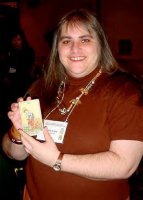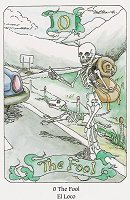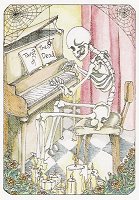|
Tarot Reflections |
October 15, 2004 |
Interview: Monica Knighton |
||||
|
Monica Knighton's unique and occasionally funny Tarot of the Dead (originally self-published) has been released by Llewellyn. In honor of this momentous event we were lucky enough to get an interview with Monica.
MK: My first deck came to me by accident. It was a prop used at a Halloween party a friend and I threw when I was twelve. It was a Marseille deck produced by Fournier. I had always been interested in symbolism - the idea that books and fairy tales had a second meaning below the surface, so Tarot quickly drew me in. MK: I used to do readings regularly, but I don't anymore. I'm more interested in the origin and evolution of symbols than in divination. I've never set out to collect decks really, but of course I've picked up quite a few that struck me - usually because of the artwork. Some of my favorites that I have are the Hello Tarot, an old set of Mexican Loteria cards, the Cavallini & Co. edition of the Soprafino Tarot and a Gypsy Witch Fortune Telling Cards deck from the 1940's. DL: What inspired you to create your deck? And what sources did you use? MK: The initial idea came from a friend and I talking about theme decks and joking around about them, but the inspiration for what went into it came from a lot of different influences around me. My father gave me his Ray Bradbury books when I was a kid, and that was my first introduction to Day of the Dead - his short story about it. This led me to reading more about it and discovering Posada's woodcuts and the work of the Linares family. I've always been a huge fan of the band Oingo Boingo, and in addition to writing songs about it, their album cover art features Day of the Dead artwork. My friend Jay collects Mexican folk masks. My favorite book on it is still The Skeleton at the Feast by Elizabeth Carmichael and Chloe Sayer. DL: How do you feel your personal & spiritual beliefs impacted on your deck? MK: My mother likes to say that she has nothing against dead people, because some of her favorite people are dead. My father would always quote Walt Kelly, saying "Don't take life too serious son, it ain't no how permanent." Thankfully, my family has always been very open about talking about death. It was strange to me growing up that other people looked at the subject as taboo. I even knew families that wouldn't let their kids go to a funeral as if it would scar them! Obviously, I think this is something that we should be open about, and hopefully that comes across in the deck. DL: When you began creating your deck did you have any intention of publishing? MK: Absolutely. It was the first thing that I ever wanted to make so badly simply because I wanted to share it. I originally approached US Games with it, but they said it was "too macabre" and they didn't like that the pip cards had emblems rather than pictures, so I went ahead with self-publishing. If I hadn't been in a position to devote a website to it, it wouldn't have happened or worked, but the timing was right. On self-publishing it, I broke even and got an education in the process, so it was a win/win situation.
MK: The booklet is a lot better! There are only a couple differences. They did full color on both sides, which was how the self-published one should have been, but it cost too much. The old black and white card back and the color title card with the skeleton playing the piano don't appear in the new deck, so that's different. From a reading standpoint, the old deck did not have a defined up or down on the Minor Arcana cards - it was purposefully ambiguous - and on the new one with the titles printed below the image, the ambiguity is gone. Many of the letters I got about the old deck were from people wanting to know exactly how to tell if a card was inverted or not, so maybe this will please them! The old deck's box was pretty flimsy because the peek-a-boo window weakened it, and the printer who did the deck had never done cards before. They didn't die cut the cards, so the corners were always a little off. Really the differences are minor. DL: How have your ties to the Tarot community (online or in the real world) impacted on your creation of this deck? MK: I wasn't talking to anyone online about the deck as I was creating it, so in that respect I was kind of in a bubble. While I was working on the deck, friends of mine who also studied Tarot would look at the designs, and in some cases the finished cards, and we'd argue over what to keep and what to change. My original Emperor card was retired and redone because it followed the Marseille design too closely and therefore didn't pair well with my Empress, who was one of the first cards I did. Having people to hash ideas out with was very important to me in doing this. DL: What other Tarot decks are you drawn to? MK: I tend to like older card decks, but it's not because I award any extra points for antiquity. I love pen and ink drawing, and different line quality, and you see more of that in the reprinted older decks than the new ones that tend to be illustrated with painting or now, digitally. It's just a by-product of what used to be the limitations of printing though. I'm pretty open as far as themes go. I just got the Manara deck, and although I'm not sure that all the images were originally conceived as Tarot images, I love the artwork and the references to film that are included. DL: What advice or suggestions would you give to others out there interested in creating their own deck? MK: Do it! It's worth it and satisfying on so many levels to go through the process! Also, with digital imaging and online print on demand services there are so many new resources available that self-publishing will be less expensive. Don't listen to people who remind you that 78-80 images are a lot to produce because if you are into it, it's a pleasure! It's also been said a billion times before, but you have to be yourself and put what speaks to you into the cards. For more information on Monica Knighton’s Tarot of the Dead, please see Valerie Sim’s review in our last issue. |
|||
|
|
||||
|
Subscribe to Tarot Reflections, and receive notification of each update! |
|
Request to be added to the list by sending email to TarotReflections-subscribe@yahoogroups.com! |
All articles remain the
property of their respective authors.
Tarot Reflections is a publication of the American Tarot Association
- Copyright (C) 2004
Questions or Comments? Contact Us.


 DL: What first drew you to Tarot?
DL: What first drew you to Tarot? DL: Do you feel there is a difference between the self-published version and the newly released Llewellyn version?
DL: Do you feel there is a difference between the self-published version and the newly released Llewellyn version?